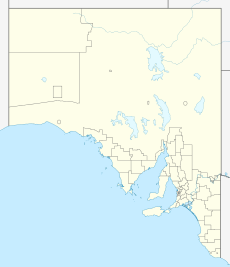White Dam Conservation Park facts for kids
Quick facts for kids White Dam Conservation ParkSouth Australia |
|
|---|---|
|
IUCN Category Ia (Strict Nature Reserve)
|
|
| Nearest town or city | Morgan |
| Established | 17 July 1969 |
| Area | 8.91 km2 (3.4 sq mi) |
| Visitation | ‘quite low’ (in 1994) |
| Managing authorities | Department for Environment and Water |
| See also | Protected areas of South Australia |
White Dam Conservation Park is a special place in South Australia where nature is protected. It's located in the areas of Lindley and Maude. This park is about 139 kilometers (about 86 miles) north-east of Adelaide, which is the capital city of South Australia. It's also quite close to the town of Morgan, about 14 kilometers (about 9 miles) north-west.
The park is managed by the Department for Environment and Water. They work to keep the plants and animals safe and healthy in this area.
History of White Dam Park
White Dam Conservation Park has had a few different names over the years. It started as the White National Parks Reserve. This part of the park was officially protected on July 17, 1969.
How the Park Grew
Later, on September 17, 1970, more land was added to the park. This made it bigger and helped protect even more of the natural environment.
Name Changes Over Time
On April 27, 1972, the park's name changed to the White’s Dam Conservation Park. This happened under a new law called the National Parks and Wildlife Act 1972. Then, on May 12, 1983, its name was changed one last time to White Dam Conservation Park, which is what it's called today. As of 2018, the park covers an area of 8.91 square kilometers (about 3.44 square miles).
What You Can See in the Park
White Dam Conservation Park is home to some interesting plants. In 1994, experts described the park's plant life.
Trees and Shrubs
The park has a type of forest called a "low open woodland." The main trees you'll find here are black oak (Allocasuarina cristata). Underneath these trees, there are many smaller plants.
Understorey Plants
The most common plant growing under the trees is bluebush (Maireana sedifolia). You might also see other plants like spear grass (Stipa species), emubush (Eremophila species), and false sandalwood (Myoporum platycarpum). Other plants include quondong (Santalum acuminatum) and nitrebush (Nitraria billardierei). These plants are all important parts of the park's ecosystem.
Visiting White Dam Park
Even though the Goyder Highway runs right through the park, not many people visit White Dam Conservation Park. In 1994, it was noted that visitor numbers were "quite low." This means it's a quiet place where nature can thrive with less disturbance from humans.
How the Park is Protected
White Dam Conservation Park is very important for nature. It is classified as an IUCN Category Ia protected area. This is the highest level of protection.
What Category Ia Means
Being a Category Ia protected area means it is a "Strict Nature Reserve." In these areas, nature is kept as wild and untouched as possible. Human visits are usually very limited, and activities like hunting or logging are not allowed. The main goal is to protect the natural environment and its processes without much human interference.


